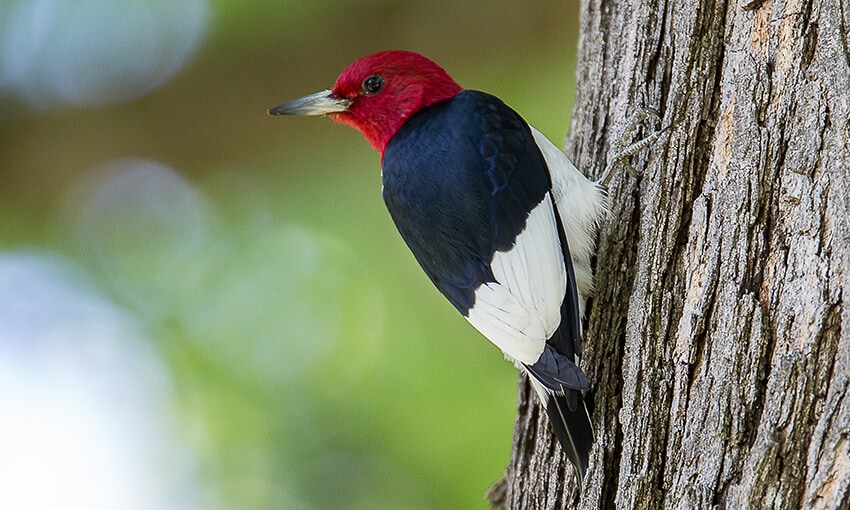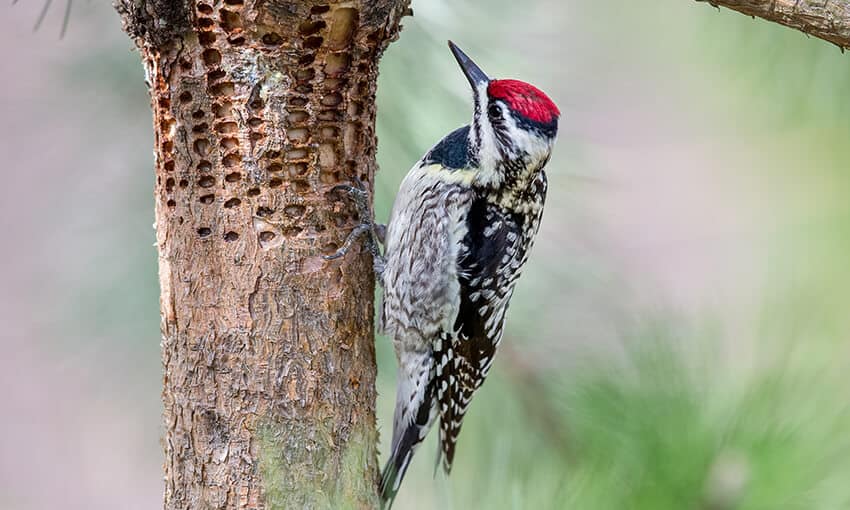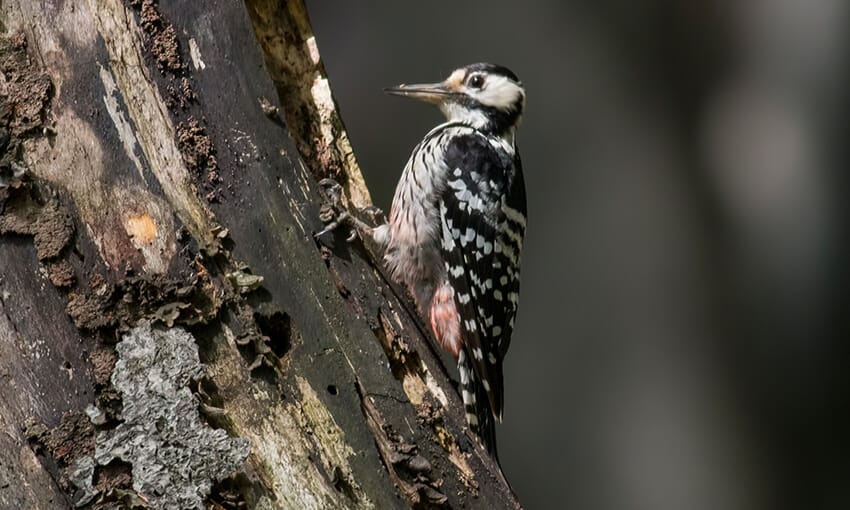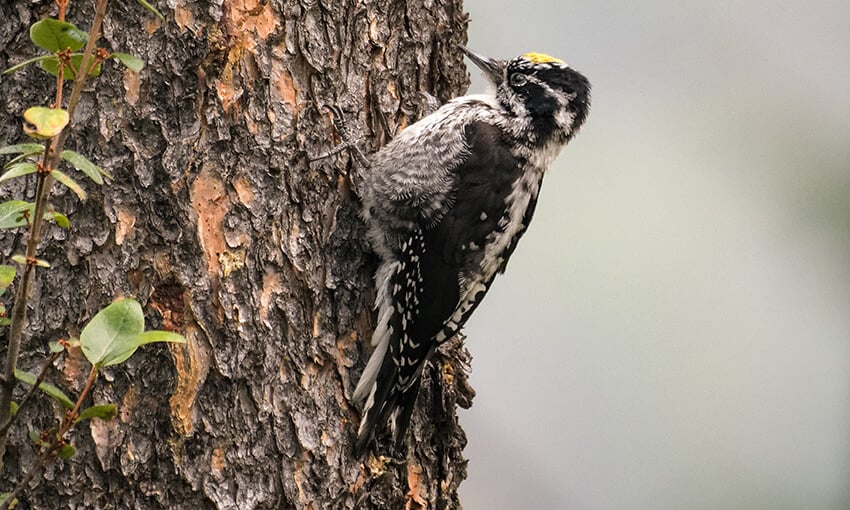Spring has passed and summer is here. For the bird-lovers among us, observing season is in full effect. No matter where you are, there’s an abundance of avian life flouting its summer brevity. From migrating raptors through the American southwest to Snowy plovers on the Pacific Coast to the midwest’s mass migration of birds from the Canadian Arctic to the Gulf of Mexico (and further). But there’s one particular bird that has gained a soft-spot in birding culture, for its creativity, noise and let’s be honest – role in pop culture: the good ol’ Woody Woodpecker.
In fact, in the State of Wisconsin you’ll find 8 commonly observed woodpeckers. Of course, there are occasional sightings of other species that are perhaps exploring into new territory or maybe just in search of some true Wisconsin cheese curds, who knows?
According to the University of Wisconsin – Madison, there are 8 species that are routinely found in America’s Dairyland: Downy Woodpeckers, Hairy Woodpeckers, Red-headed Woodpeckers, Pileated Woodpeckers, Yellow-bellied Sapsuckers, Red-bellied Woodpeckers, Northern Flickers and Black-backed Woodpeckers.
There is a 9th species that could be included in the list although it is found in a more defined range: the American Three-toed Woodpecker.
Let’s start by introducing each of the species present in Wisconsin (doesn’t it feel like this would be a good time to have boxing legend Michael Buffer to do a voice-over, “In the blue corner, standing at 9.8” and a whopping 50g, the Haaaaairy Woodpecker)…
Okay, maybe not.
Anyways, each of Wisconsin’s Woodpecker species plays a special role and lives under different means of survival. Let’s check them out.
Woodpeckers in Wisconsin
The Downy Woodpecker

Colors: White backs with black wings peppered with white spots. Males will have a small red-patch on the back of their head.
Weight: 0.74 – 1 oz
Length: 6-7”
Wingspan: 10-12”
A little more info:
Downy woodpeckers are abundant in many regions of the United States, in fact describing their range is better done by listing omissions than it is listing regions in which they exist. Hawaii and particular patches of Texas, New Mexico, Arizona, Nevada and Alaska are the only parts of the US where Downys have no presence. As one might expect, Downys are small birds, and thus their lifespan is proportional – often just a year or two long. Another interesting fact about Downys is that they are one of just a few species of birds that seem to be unaffected by habitat fragmentation – an increasing problem as landscape use and development continue to put pressure on wildlife populations in the US.
The Hairy Woodpeckers

Colors: Similar, almost exactly, to the Downy – white backs, black wings with white spots and males with a red-patch.
Weight: 1.4 – 3.4 oz
Length: 7-10.2”
Wingspan: 13-16.1”
A little more info:
Much like the Downy, in more ways than one, Hairys have an extensive range crossing the entirety of the continent of North America and spanning from Central America to regions of Northern Canada. Like most trans-continental species, they have regional differences. The Hairys in Wisconsin have distinct black/white markings and beaks that are at the very least the length of their heads. Hairys are important species in forest fire ecology, commonly found rummaging through the remains of burnt trees and protecting forests from bark beetles infestations.
Red-headed Woodpeckers

Colors: Crimson-red head, stark-white body, half-and-half wings (black and white).
Weight: 2-3.2 oz
Length: 7.5-9.1”
Wingspan: 16.5”
A little more info:
These woodpeckers have carved out a niche for themselves, not relying solely on the food source provided by trees, downed logs and other sedentary sources but being highly efficient mid-air hunters. They thrive in forested/treed areas that have open underbellies because they offer more potential for their diverse hunting habits. The Red-headeds are known for being highly territorial and thus have earned a place in Native American folklore as a war symbol.
Pileated Woodpeckers

Colors: Black base with strong white stripes through the neck and a bright-red crest and distinct white underwings. Males may have a red-stripe along the cheek leading into the beak.
Weight: 8.8-12.3 oz
Length: 15.8-19.3”
Wingspan: 26.0-29.5”
A little more info: Pileated woodpeckers are the largest woodpeckers in North America, often compared in size to a full-grown Crow. Likely in part due to their size, Pileated woodpeckers dig out perfect rectangular holes in trees, specifically to find ant colonies. These digs are so significant that they can often lead to trees snapping at the excavation site. The range of Pileated woodpeckers is much more confined, with virtually no presence in the American West (besides the Pacific Coast) and no population in the midwest until Wisconsin. Pileated woodpeckers are also known for their deep and rhythmic drums on trees during excavation.
Yellow-bellied Sapsuckers

Colors: Strong black-white definition with well-defined facial striping patterns. Both sexes have red on their foreheads and males also carry red coloring on their throats. When the wing is folded there is a white strip down more than half of the wing length. Some birds have white/yellow underbellies (hence the name.
Weight: 1.5-1.9 oz
Length: 7.1-8.7”
Wingspan: 13.4-15.8”
A little more info:
One of the few woodpeckers that doesn’t span its range into the West Coast, the Yellow-bellies actually use Wisconsin as their natural boundary to their habitat range. In fact, they are the only species of Woodpecker in the Eastern half of North America that are fully migratory, meaning they rarely spend an entire year in the same territory (unlike most species). As hinted by the name, Yellow-bellies consume sap from trees and have been found to tap nearly 1000 species of trees to find sap.
Red-Bellied Woodpeckers

Colors: The color pallet of Red-bellies is often described as being pale or tinted, in other words, not strikingly bright. A geometrically striped back of black and white with a red-ish cap and some blotchy redness along the chest and belly.
Weight: 2-3.2 oz
Length: ~9.4”
Wingspan: 13-16.5”
A little more info:
Red-bellies are more interested in carefully picking apart the outer-bark of trees than drilling deep into the core of the tree. They have highly developed and unique hunting/foraging techniques which include the use of their extremely long tongues (which can extend up to 2” past the end of their beaks). In addition, they often place nuts into tight crevices and use them as support systems to break the shells open. Red-bellies have been observed partaking in complex learning experiences where young birds practice evasive flying.
Northern Flicker

Colors: As with most woodpecker species, coloration varies slightly with region (east vs. west). Generally a brown tint with a white bottom. The underside of the wing is bright yellow. The birds often have noticeable black spotting and patches.
Weight: 3.9-5.6 oz
Length: 11-12.2”
Wingspan: 16.5-20.1”
A little more info:
These woodpeckers love to forage near the ground rather than higher on tree trunks. While it possesses the ability to dig into bark like other woodpeckers, it prefers to hunt through the dirt and use its barbed tongue to scoop up ants from the ground. Like some other species, the Flickers use their drumming not only as means to drill for food but also as a sign of territorial protection.
Black-backed Woodpeckers

Colors: Matte/ink black backs with white bellies and striping on the sides. Mostly black heads with a small white line above the beak and a yellow crown on males and juveniles of both species.
Weight: 2.1-3.1 oz
Length: ~9.1”
Wingspan: 15.8-16.5”
A little more info:
Black-backs thrive in post-fire habitats and forests that have undergone large die-off. These woodpeckers often spend a considerable amount of time digging in a single spot to reach deep-seeded beetle larvae inside the core of dead/dying trees. This is one of the more rare species in Wisconsin, making appearances only the upper half of the state. In fact, the distribution of the Black-backs throughout the US is quite remarkable and is still cause for some questions as to what sort of biogeographical barriers could produce such distinct borders for the species.
American Three-Toed Woodpeckers

Colors: Similar in stature and coloration as the Black-backed woodpeckers, American Three-toes have black and white striping down their backs with spotting/blotching of black and white on the belly. The males have a yellow patch on their forehead.
Weight: 1.6-2.4 oz
Length: 8.3-9.1”
Wingspan: 14.6-15.3”
A little more info:
Like the Black-backs, these birds spend long periods of time working on a single tree. That being said, instead of drilling deep into the tree, they comb the entirety of the bark perimeter. Only Black-backs and American Three-toes have three toes, making it easier for them to produce more powerful blows during drilling. Their distribution follows closely with the range of spruce trees, not because spruce trees are their only available habitat but because they often find beetle infestations with spruce forests.
So, how can you attract these woodpeckers to your backyard habitats?
There are a variety of methods available to increase the attractiveness of your backyard habitat to these woodpeckers. Even though Woodpeckers are special little creatures with a very niche habitat and hunting type, they usually follow the common patterns of attracting birds. In addition to the common backyard birding methods, such as putting up species specific feeders and feed-types, creating distinct perching/bathing stations and putting up bird houses that could be used by woodpecker species, making sure that you keep any dying or rotting trees (snags) in the yard can be vital since so many of these guys rely heavily digging through bark for their insectivore needs.
That being said, let this be a warning…
If left unchecked, a high presence of woodpeckers in close proximity to your home can result in significant damage to your house’s siding. So, make sure you keep a healthy balance between inviting these little drummers into your backyard and protecting your house.
And most of all, enjoy watching and attracting these wonderful, unique little birds that call Wisconsin home.

